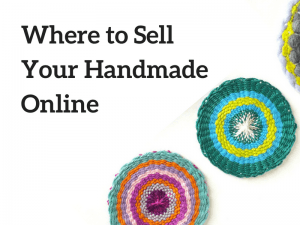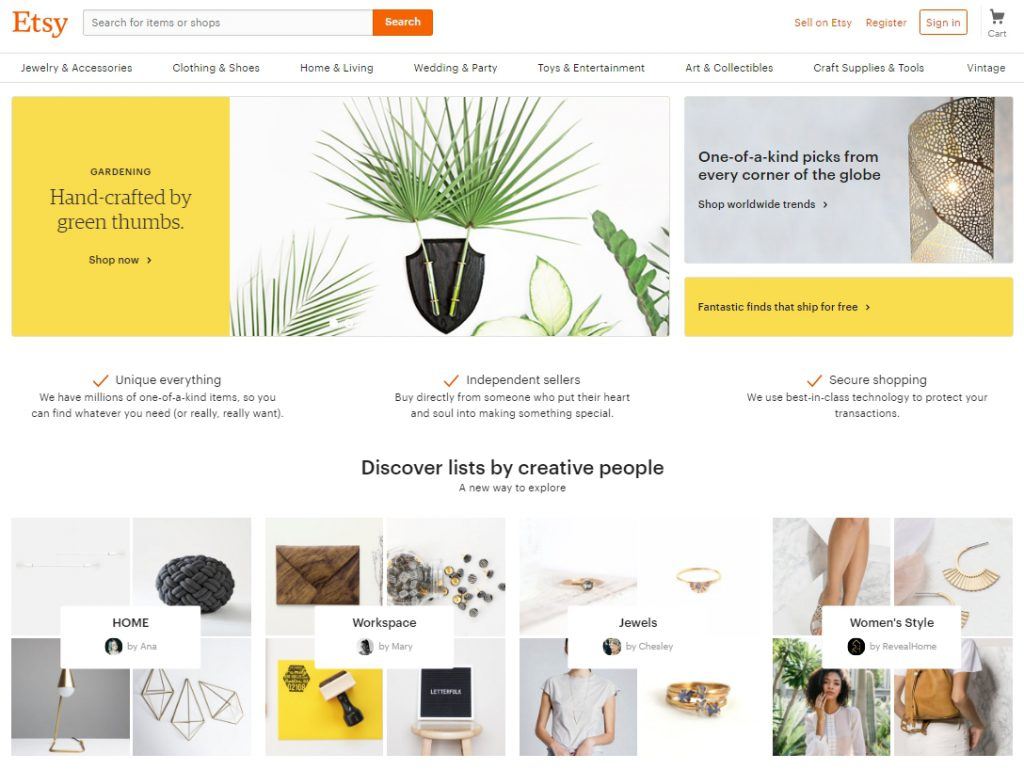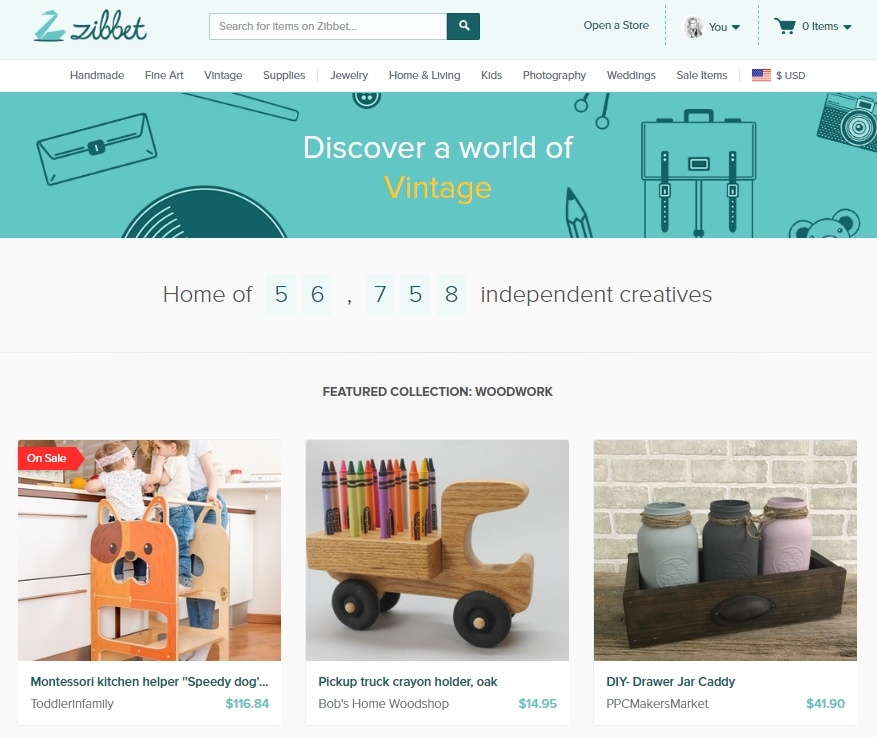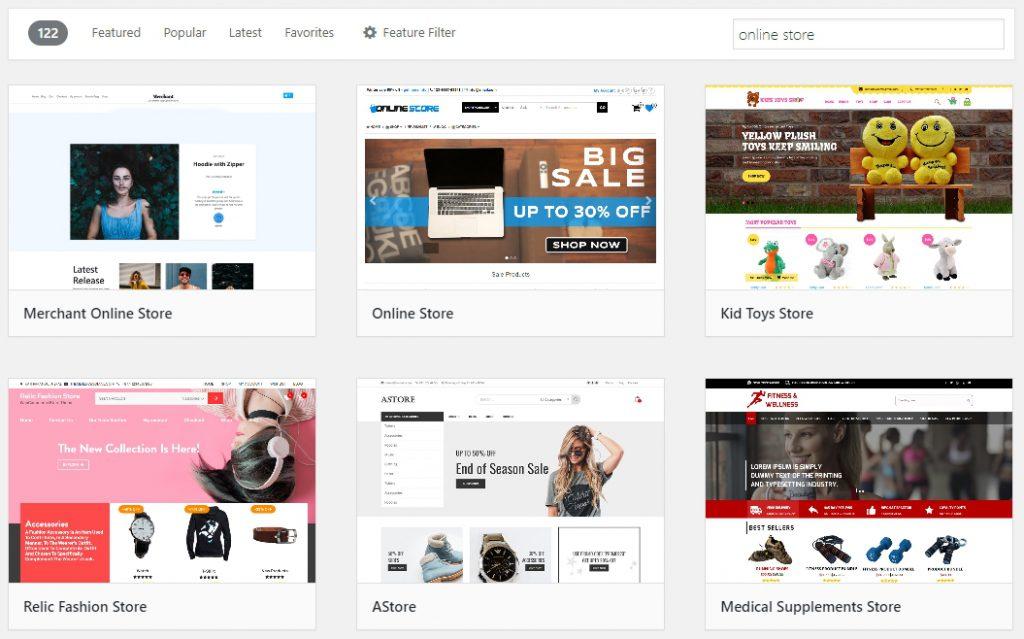 The world of eCommerce has expanded beyond our wildest imagination. Nowadays, it’s easier than ever to put a product out there to get someone’s attention and it’s not just limited to the big brands. Small creators like you can do it too, and in today’s entrepreneur tip, I’ll be showing where to sell handmade items online so that you can start growing a successful business.
The world of eCommerce has expanded beyond our wildest imagination. Nowadays, it’s easier than ever to put a product out there to get someone’s attention and it’s not just limited to the big brands. Small creators like you can do it too, and in today’s entrepreneur tip, I’ll be showing where to sell handmade items online so that you can start growing a successful business.
1 – Marketplaces
These platforms are ideal for one thing and that’s traffic exposure. Considering their influences, getting your products listed on the marketplaces can actually get more eyeballs and potentially more sales. No wonder it is one of the most favorite go-to options for newbies. The only downsides are probably competitions as well as certain fees that must be paid in exchange for that traffic.
Even so, that shouldn’t discourage you so let’s see what are some of the popular marketplaces that you can participate.
Etsy

Often referred to as an online flea market, Etsy is home to a community of independent businesses that focus on selling handmade goods, vintage items, and craft supplies. With over 150 million visitors per month, the platform provides a lot of back end support (including apps) to help sellers attract customers, especially during the holiday seasons.
It cost 20 cents to list an item and they charge a 5% transaction fee of sales and shipping. So if an item is worth $50 with a $5 shipping rate, the fee would be 5% of $55, which amounts to $2.75. Soon, there will also be access to advanced shop customization, restock notifications and advertising credits for $10 per month through the Etsy Plus package.
Ebay
EBay is notably the second largest marketplace on Earth and gets about 1.1 billion visitors every month. Even though they target a wide range of audiences, they do offer a huge section for arts and crafts as well. Take note, however, that you are up against tough competitions with wholesalers, mostly from China.
Their numerous fee structure has always been a subject of discussion which many views as taking a big cut into their profits.
Amazon Handmade
This department is a part of the general Amazon marketplace and it is fairly new as compared to the previous two. Amazon Handmade has a strict application process and requirement for sellers. Firstly, they forbid mass-produced products and would oftentimes request sample submissions to the determine the authenticity before granting approval.
Just like other marketplaces, product settings must be tweaked in order to boost their spots in the search results. Otherwise, it will also not show up in the competitive marketplace.
There are two ways to go about selling. If you are fulfilling orders for your product sales (FBM – Fulfillment by Merchant), the referral fee that you need to pay to Amazon is 15% of a product retail price plus shipping cost.
If you are selling at least 40 items per month, then it’s wiser to use the professional sellers account which costs $39.99 per month. This will help to save money on fees and give access to management tools, volume listing and the eligibility to compete for the buy box.
Getting your products seen on Amazon is a huge thing because you are getting mostly targeted audience who are looking for quality versus quantity. Therefore, it could be worth investing to leverage from the traffic of 2 billion visitors per month.
Zibbet

Zibbet is a much smaller marketplace for independent artists and crafters who are looking to create their own online presence. The platform features 4 main categories – handmade, fine art, vintage (items over 20 years old) and craft supplies. While fees aren’t charged for listing or selling, sellers can create their own online store from within through subscribing any of the following hosting packages.
- Starter – $4/month (sell up to 50 items)
- Pro – $8/month (unlimited items)
- Unlimited – $16/month (unlimited items plus full customization)
2 – Facebook
Facebook itself has also evolved into something that’s more than just a social network. There are now features whereby you can start selling things right from your phone. The easiest method is called Facebook Marketplace which is something like Craigslist whereby sales are locally oriented.
When viewers find something that they like, they will send a private message to the seller and arrangement is made to exchange goods for money. Facebook, doesn’t in any way participate in the transaction process and is merely used to feature product listing for free.

Once you are in the marketplace, you can start uploading product pictures and descriptions by clicking ‘Sell Something’ and publish them according to your locality. It’s very simple to use and ideal for home-based businesses, thrift store owners or even local businesses that are having sales.
A slightly more complicated process is to sell through a Facebook store. For this you need to first create a Facebook business page and add a shop section to that page. The payment processing can be done in two ways. The first is through the Facebook page itself (only available in the US for now) and the other involves re-directing customers to another website, like a personal online store, to complete the purchase.
If you are setting up accounts through PayPal or Stripe, credit card fees will vary between the range of 2% to 4% per transaction. Here’s a detailed video that will walk you through the step-by-step of creating a Facebook store.
3 – E-commerce Solution
Up to this point, we have been talking about ways around the external platforms that clearly offer a lot of advantages. However, being dependant on their features means that there’s nothing you could do if they change policies or worse, shut down their sites.
This is where you would want to consider setting up something that gives you more control over the way you market handmade products. Personalizing a business will put you in charge and I am talking about creating an online store that truly belongs to you.
For starters, you get to have your own brand through a custom domain name and there’s no need to squeeze in a small spot in an overcrowded platform. Many companies that specialize in eCommerce can provide you with an out-of-the-box solution that streamlines everything from optimized product listing to a secured payment gateway for the customers.
They are very professional-looking, offer great technical support and cater for different business sizes. What you need to do is to choose the best hosting package that suits your budget and product volume.
- Shopify – 3 pricing plans, ranging from $30 to $300 per month.
- BigCommerce – 3 pricing plans, ranging from $30 to $250 per month.
- Volusion – 4 pricing plans, ranging from $15 to $135 per month.
All these three companies are very established and they also offer free trials to help you decide on the right plan.
4 – WordPress Online Store
If you are someone who’s adventurous and don’t mind getting your hands dirty with the technical stuff, then WordPress is likely your choice. What was originally a blogging platform can now be transformed into an online store through specific plugins and themes to enhance eCommerce functions.

As such, it offers a lot of flexibility and diversity to one’s business presence. Granted, it comes with some learning curve, but once you are used to it, the skills will reward in multiple folds. It’s like building something with Lego bricks and thus, anything you imagined, is possible.
While WordPress is free software, good quality hosting services usually cost between $30 to $50 per month. After purchasing a domain name, you would link to a hosting provider of your choice and can begin to build the store from the ground up.
Here are other benefits of the platform that may interest you;
- You can write articles about your products to offer inside stories about how and why you make them and then link this information to the online store.
- Every article that you write will boost your business brand, help people to discover your products through the search engines and increase your authority in the niche.
- While selling your products, you can also earn extra income from affiliate programs, promoting supplies that you used from various retailers. When someone buys through the affiliate links, you’ll get sales commissions to supplement your work.
- If you are someone who likes to teach, you can also conduct online courses and make a profit from selling digital products online. See? Now there are more ways to make money than just creating an online store. I bet you never thought of that, uh 🙂
To get a sneak peek experience with WordPress, simply create a site using the plugin below. It’s free so just give it a go!
Made For Success
I know there are many of you creative people who aspire to become successful in whatever you do and the good news is, you can do so without restriction on the internet. Gone were those days of building a brick-and-mortar store. Now that you know where to sell handmade items online, the rest is just taking action and making it happen.
I hope this piece of content has been helpful to you. If you like to learn more about the nuts and bolts of creating an online business, do check out my recommended training platform here.
Question – What experience do you have as a craft seller and what has worked for you so far? Please share your thoughts or questions in the space below.

Just to share an experience. My sister has been selling customized T-shirts online for years. She first started with local eCommerce here at Jumia before moving to Amazon and then later, got into eBay where she actually cash out the most. She now has people working for her. Just goes to show that there is no limit to how much one can make on an internet business.
I have tried eBay and Amazon before, but those platforms are very challenging due to the massive amount of competition. I am wondering if Zibbet would be a better marketplace to sell handmade items. They look decent and have an affordable pricing for smaller sellers.
I love handmade crochets and I have a large collection of them lying in my drawers, but never really thought of selling them, especially on Facebook. This post has inspired me with some new ideas. I don’t know if setting up a WordPress store would be a good idea as I don’t see myself as an eCommerce seller just yet. Will venture into that later.
Some great ideas you have there, Cathy. My wife enjoys making handmade stuff and I always tell her that she can make some nice money with that type of skill. I personally think that the best place for this is Etsy as they have very low shipping fee which is important for potential customers. The Facebook marketplace is also a great way to deal with, but I think it’s more targeted for a certain locality.
Wow,
Excellent article and well written. My wife has been selling a craft for years online. She started out on ebay, then to Etsy, and then to Amazon.
Her best seller is Ebay. Her cost to make her products (not counting labor) is about $2-3. Her average sale is probably $18-25. I have seen her make as much as $2,000 before cost during the winter months.
I never even considered having her set up an actual website. I myself run a blog through WordPress and I never even considered making her a website for her.
I found this article very informative and will be sharing the Amazon Handmade with her. I do not think she is aware of that part yet on Amazon.
Thank you so much for taking the time to share!
Hi Cathy,
Some great advice in here. Facebook Marketplace has certainly proved useful to me in selling some of my stuff online, although it tends to lend itself better to local marketing rather than national/international, but this is probably what you want with home produced items, particularly if they’re a bit heavy or bulky.
I’d like to add, I use SiteRubix myself for all my sites and I’ve found their WordPress hosting is excellent and the tech support is quick if you ever need some help. Highly recommended.